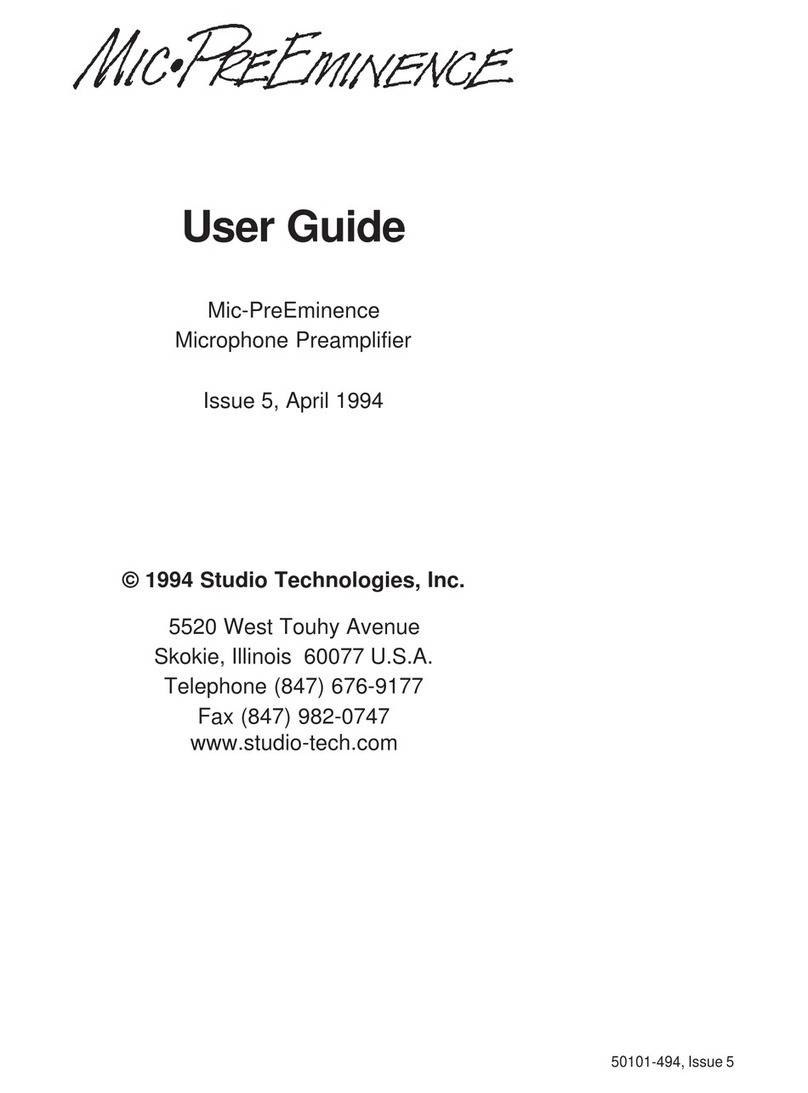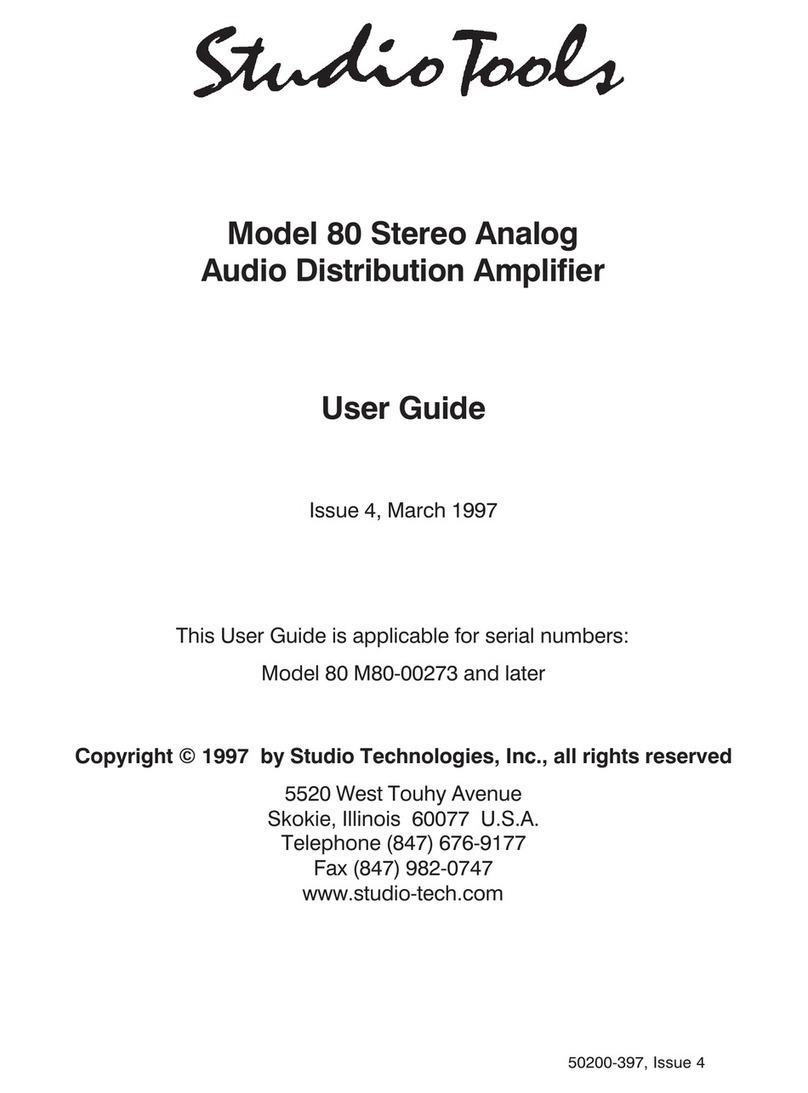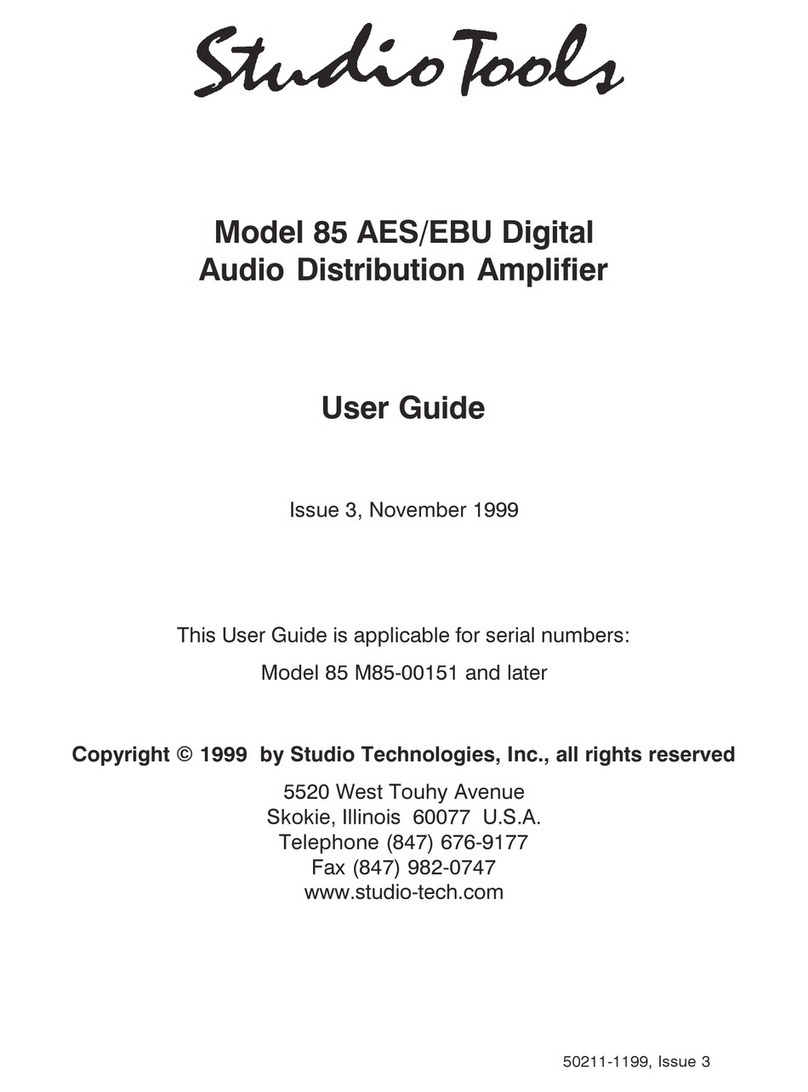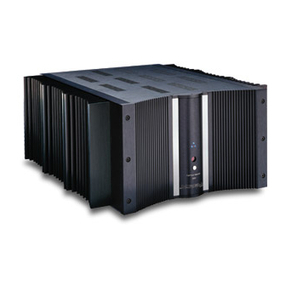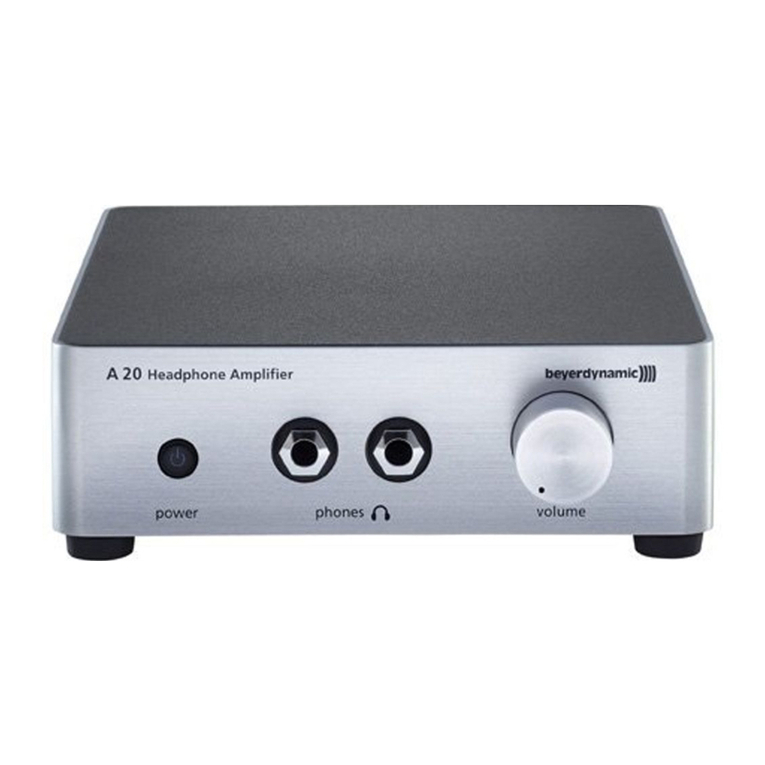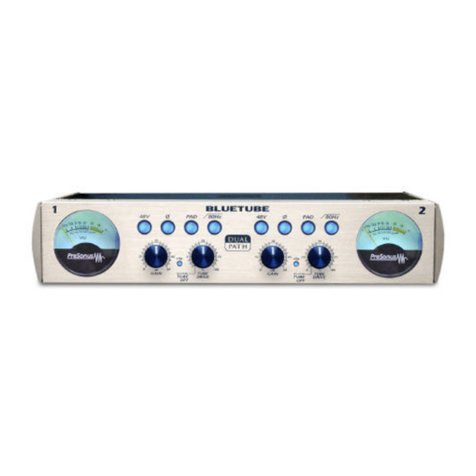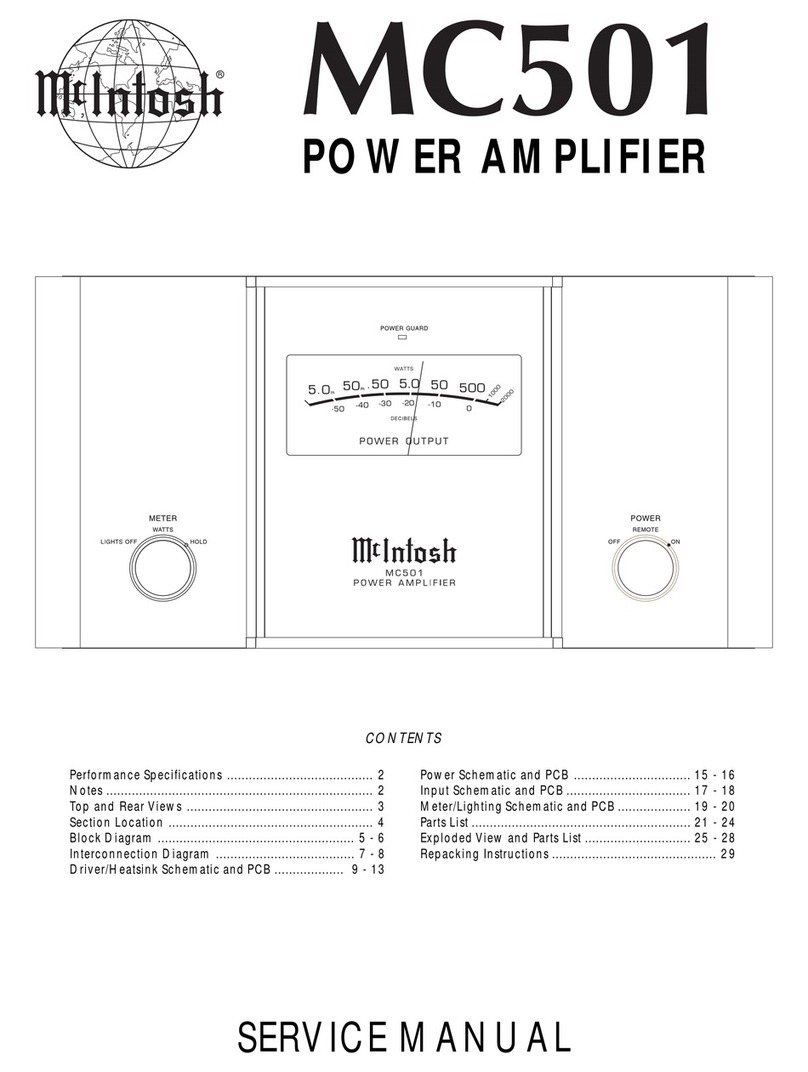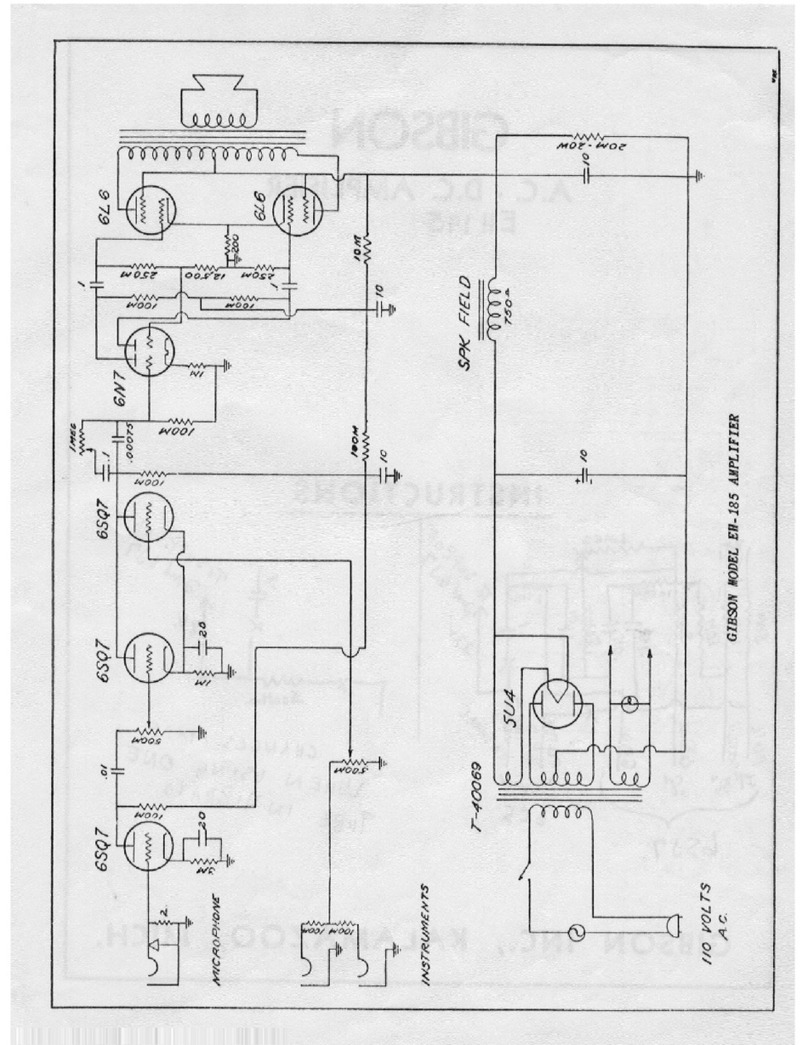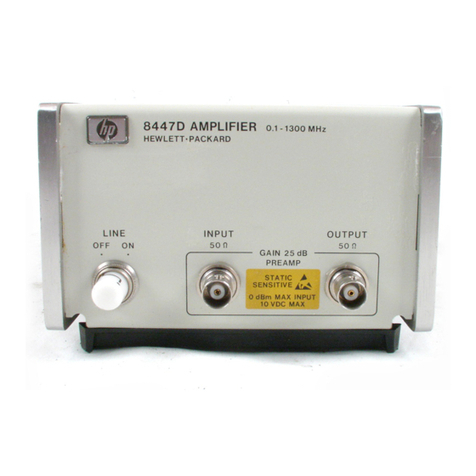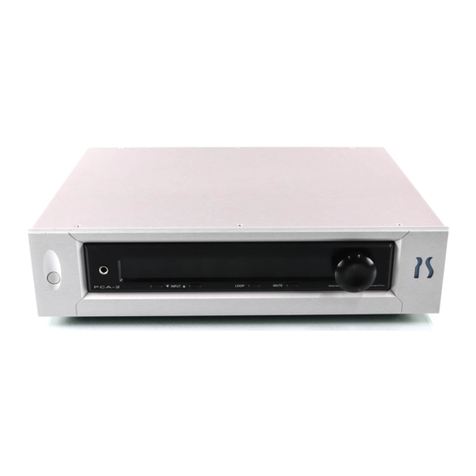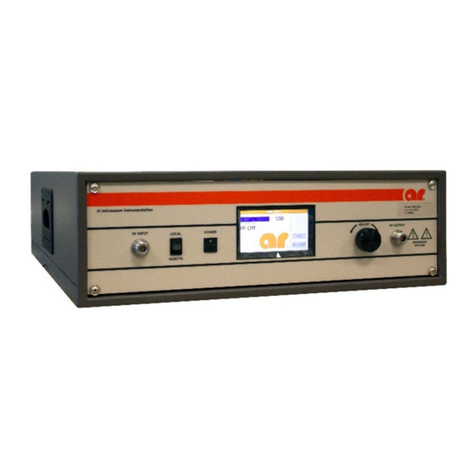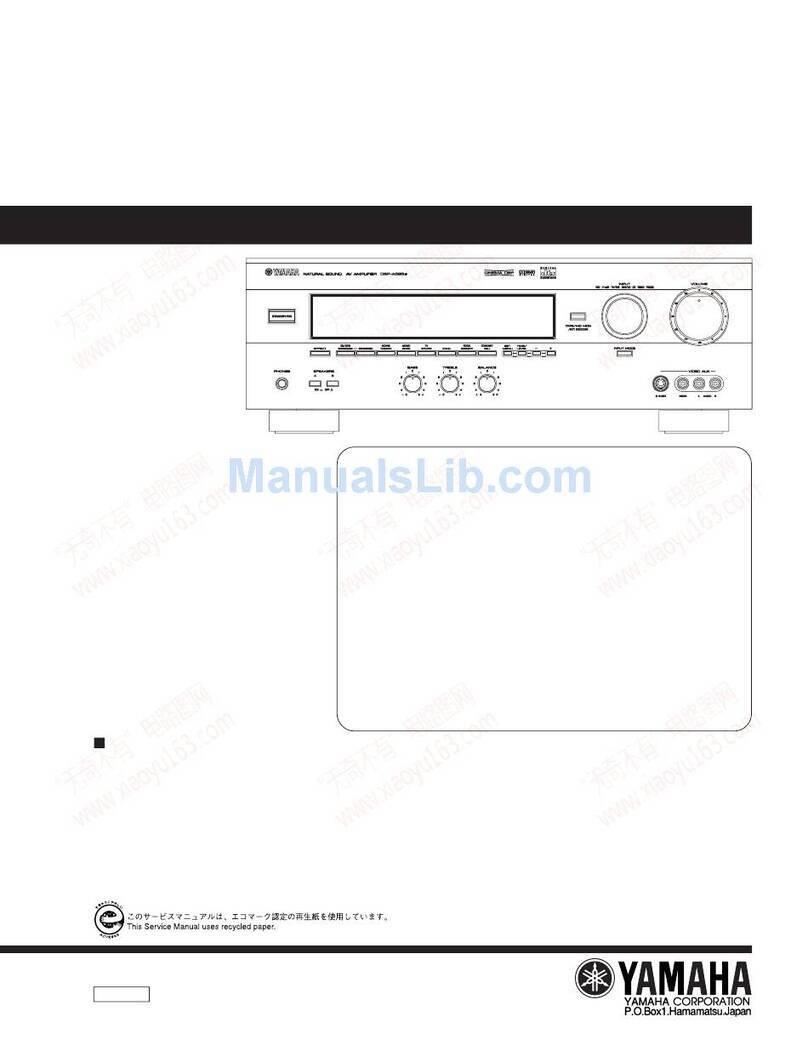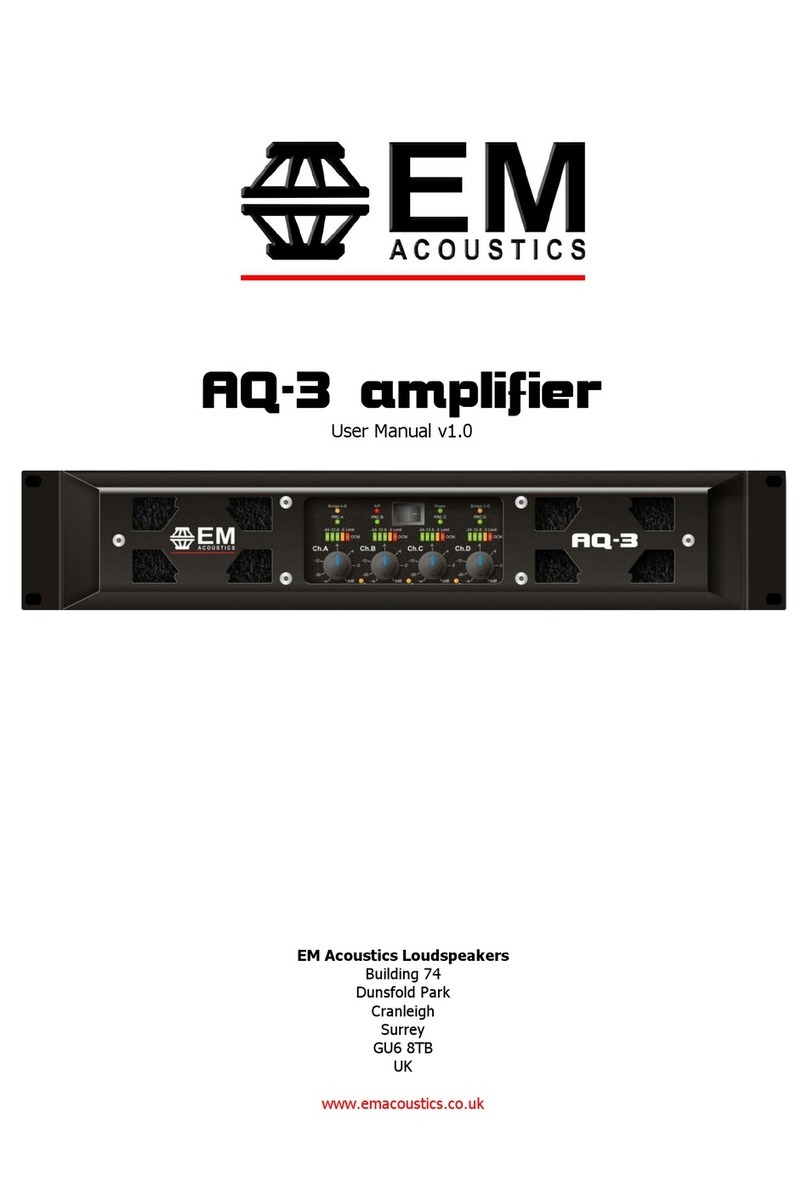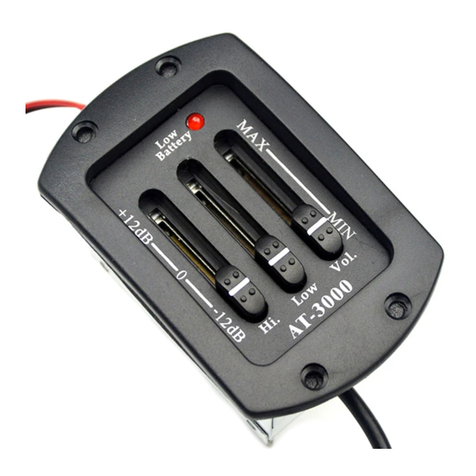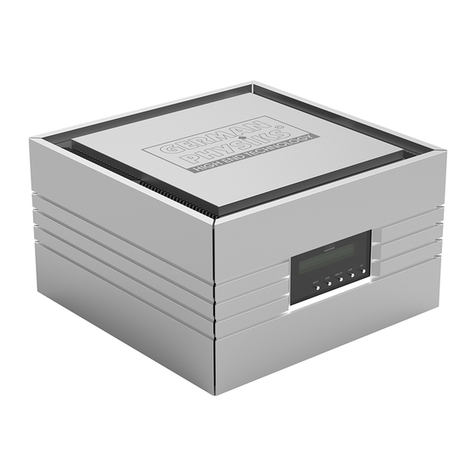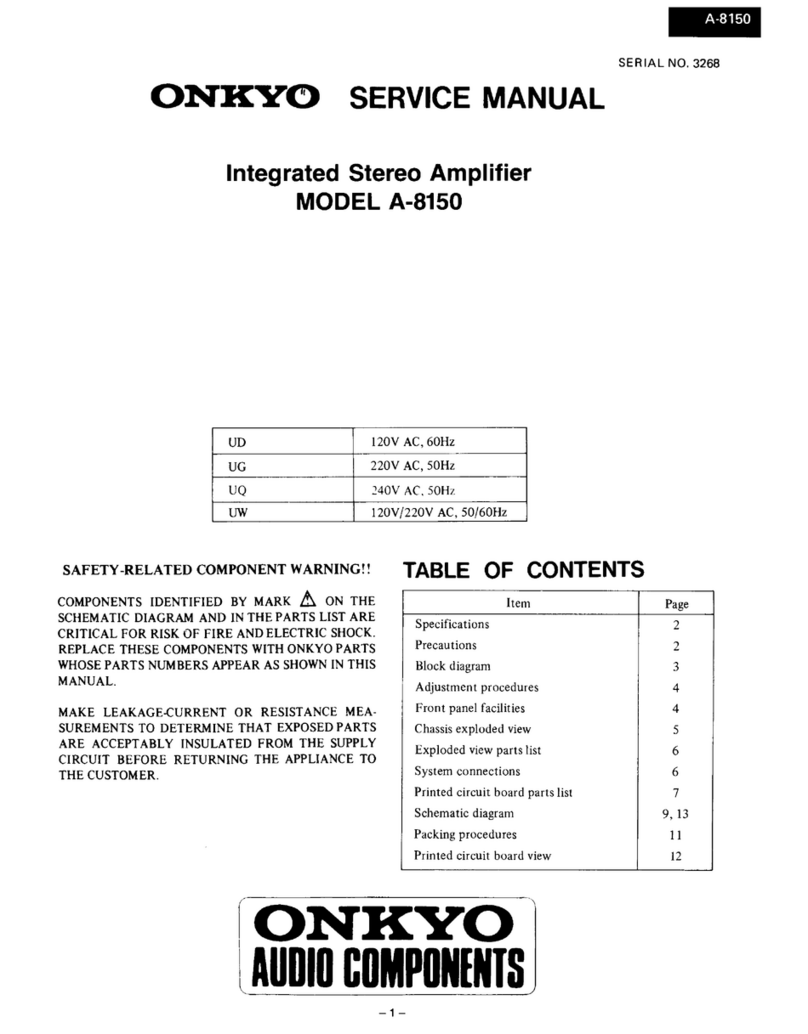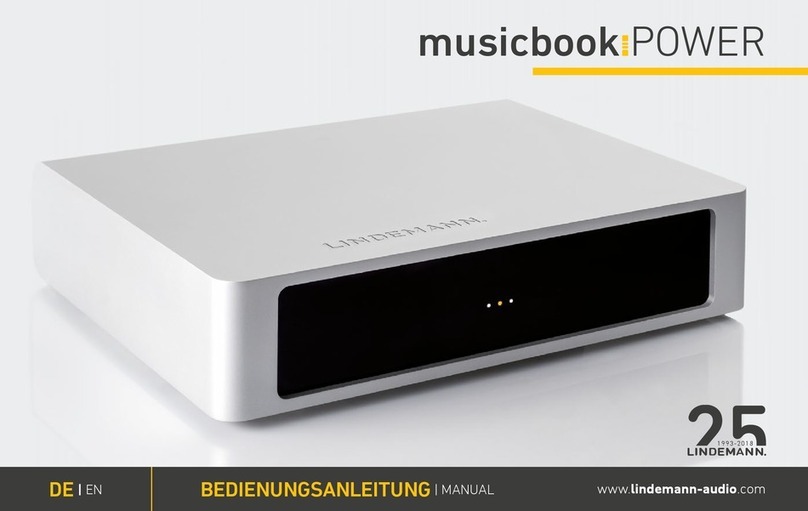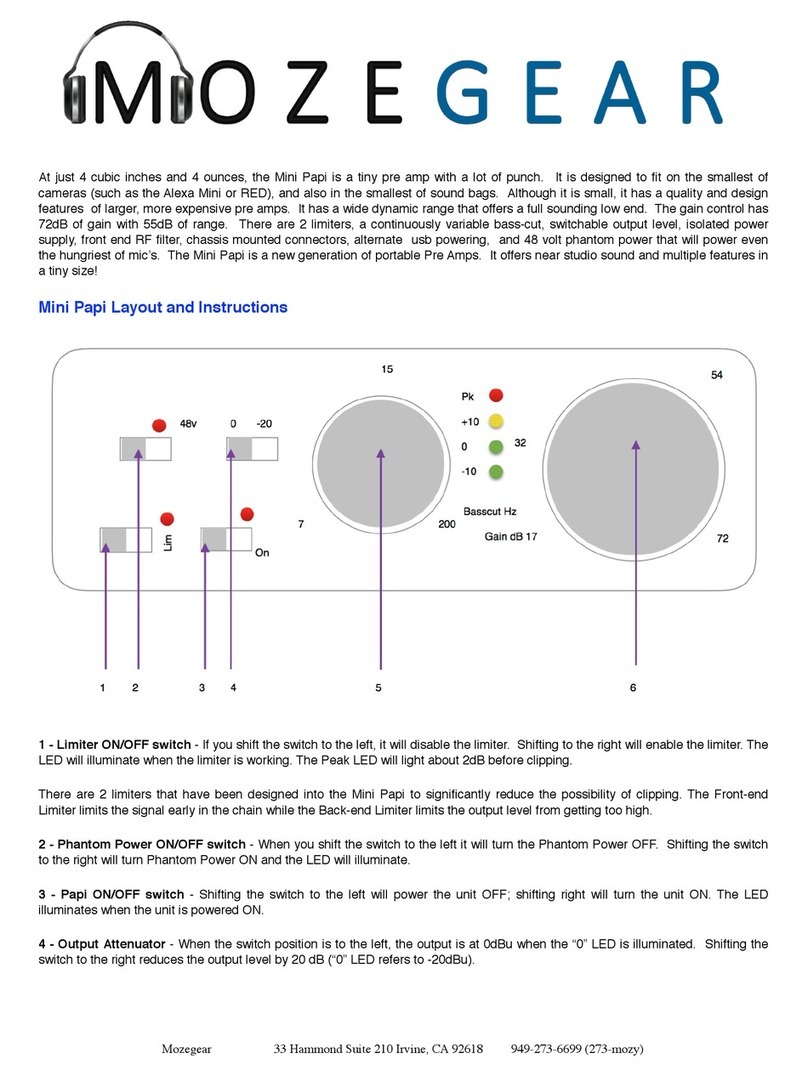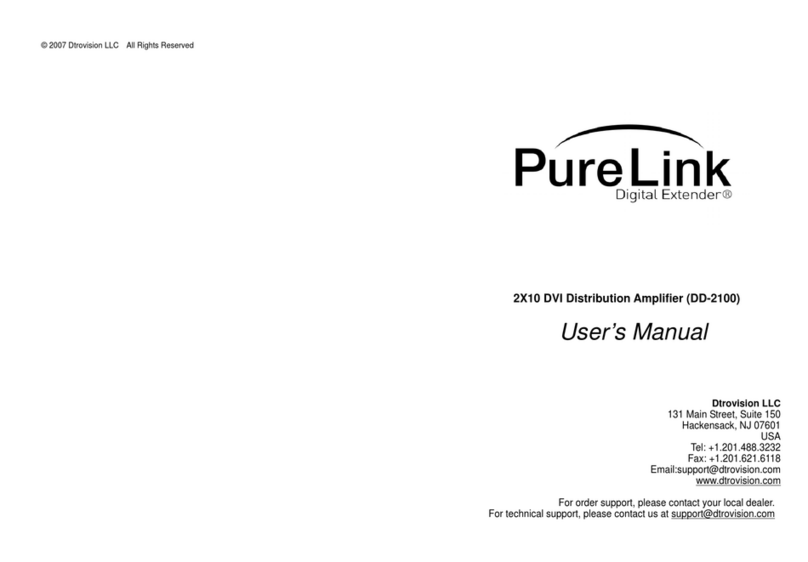Studio Technologies 34 User manual

Copyright © 2005 by Studio Technologies, Inc., all rights reserved
www.studio-tech.com
50163-0805, Issue 1
User Guide
Issue 1, August 2005
This User Guide is applicable for serial numbers:
M34-00151 and later
Model 34
Talent Amplier

This page intentionally left blank.

Model 34 User Guide Issue 1, August 2005
Studio Technologies, Inc. Page 3
Model 34
Talent Amplier
Introduction
The Model 34 Talent Amplier is a self-
contained listen-only “belt pack” unit that
drives talent earpieces or headsets. The
unit is powered by, and receives audio
from, single- or dual-channel broadcast-
standard IFB or party-line intercom cir-
cuits. A 3-conductor microphone-type
cable links the IFB or intercom circuit
with the Model 34’s input. The unit’s
resources were selected so that a range
of single- and dual-channel applications
can be supported. For exibility the dual-
channel audio output is provided on both
¼-inch and 3.5 mm jacks. The jacks are
3-conductor and are compatible with
both monaural (2-conductor) and stereo
(3-conductor) plugs. An LED indicator
lights whenever input power is present,
providing setup assistance and user con-
dence. The Model 34 is housed in a light-
weight, yet rugged, aluminum housing. A
belt clip allows it to be directly attached
to clothing or accessories. An optional
mounting adapter is available, enabling
the Model 34 to be installed in a perma-
nent location.
Model 34 Back Panel
Model 34 Front Panel
Power
present
LED
The Model 34 is intended for use by on-air
broadcast and production support person-
nel. The unit provides two user-accessible
rotary level controls and an output mode
switch. The switch is used to select how the
one or two audio input sources are routed
to the connected earpiece or headset. In
the switch’s stereo position input chan-
nel 1 (XLR pin 2) is sent to the left output
channel while input 2 (XLR pin 3) is sent to
the right output channel. The two controls
allow the left and right output levels to be
independently set. When the output mode
switch is set to the mono position, a “mix”
of input channels 1 and 2 can be created.
Using the level controls, camera or produc-
tion personnel can create a unique cue mix
of either or both audio inputs. This allows
independent IFB signals, such as those
intended for use by on-air talent and tech-
nicians, to be simultaneously monitored.
By design, the Model 34’s level controls
cannot be set to fully attenuate (“mute”)
the input sources. This helps to ensure that
users will never accidentally miss important
“cues” from directors or producers. While
audio quality is not normally considered
Channel 1/
Left Output
Level
Channel 2/
Right Output
Level
Mono/Stereo
output mode
3.5 mm
(3-Conductor)
Output
IFB or Party-Line
Intercom Input
1/4-Inch
(3-Conductor)
Output

Issue 1, August 2005 Model 34 User Guide
Page 4 Studio Technologies, Inc.
Model 34
Talent Amplier
a factor in IFB or intercom systems, the
Model 34 is built to “pro audio” standards.
This helps to ensure that the best possible
audio reproduction is provided.
The Model 34 is compatible with virtually
every standard broadcast IFB and party-
line intercom circuit. This type of circuit
typically uses 3-pin XLR-type connectors
for interfacing with connected equip-
ment. XLR pin 1 serves as common for
DC power and audio. Pin 2 provides DC
power and, in the case of a dual-channel
circuit, DC power and channel 1 audio.
Pin 3 provides channel 2 audio in dual-
channel systems or channel 1 audio in
single-channel systems.
Model 34 units have been tested for
correct operation with IFB and intercom
circuits associated with systems from
RTS™/Telex®, Clear-Com®, and Studio
Technologies. Good performance can be
expected when the Model 34 is used with
IFB circuits associated with the ubiquitous
RTS Model 4010 Central Controller and
IFB-828 Interface. With IFB circuits provid-
ed by interface units from Studio Technol-
ogies, excellent audio quality and support
for lengthy cable runs can be expected.
Connection and
Operation
As expected, connecting and using
the Model 34 is quite simple. The IFB or
party-line intercom circuit that is going to
provide the unit’s power and audio signals
is connected to the Model 34’s 3-pin
female XLR-type connector. It is located
on the back panel and labeled INPUT. The
cabling associated with the IFB or inter-
com circuit must conform to the broadcast
standard. With dual-channel circuits pin 1
serves as common for power and audio,
pin 2 has positive DC with channel 1 audio
superimposed on it, and pin 3 has chan-
nel 2 audio. With the less-common single
channel IFB or intercom circuits, pin 2
will have power only while pin 3 will have
channel 1 audio. Upon connecting the IFB
or intercom circuit the power-present LED,
located on the front panel, will light.
Virtually any pair of headphones, head-
sets, or earpieces can be connected
to the Model 34’s audio outputs. For
convenience both ¼-inch and 3.5 mm
3-conductor (“stereo”) jacks are provided.
The jacks, located on the back panel, are
internally connected in parallel (“multed”)
with the same circuitry driving both. Devic-
es that use monaural (2-conductor) or ste-
reo (3-conductor) plugs can be connected
into either jack without impacting the unit’s
performance. Protection resistors, electri-
cally in series with the left and right output
circuitry, prevent damage when mono
(2-conductor) plugs are inserted.
Level Controls and Output
Mode Select Switch
Two rotary level controls and a 2-position
output mode select switch are located
on the Model 34’s front panel. How the
controls and switch function depends on
the type of IFB or intercom circuit that’s
been connected to the unit, as well as the
specic type of headset or earpiece being
used. The main variables are whether the
IFB or intercom audio source is dual- or
single-channel, and if the connected trans-
ducer uses a monaural (2-conductor) or
stereo (3-conductor) plug.

Model 34 User Guide Issue 1, August 2005
Studio Technologies, Inc. Page 5
Model 34
Talent Amplier
The level control labeled CH1/LEFT
adjusts the output level of the signal asso-
ciated with pin 2 of the connected IFB or
intercom circuit. In television sports broad-
casting applications this is often called the
“interrupt” channel but actually consists
of program audio that is interrupted with
talkback audio. In live radio applications
the user cue signal might be stereo,
with the left channel normally carried
on pin 2. The level control labeled CH2/
RIGHT adjusts the output level of the sig-
nal associated with pin 3 of the connected
IFB or intercom circuit. In the television
IFB world this is often referred to as the
“program” or “program only” channel. For
a stereo source this would most likely be
the right channel.
When the Model 34 is used in on-air
broadcast applications, the level controls
are specically congured to prevent full
attenuation of the audio signals. By limit-
ing the maximum attenuation to 40 dB,
important talent cue signals will be less
likely to go unrecognized. A user can’t
accidentally (or purposefully) turn “off”
their cue feed.
The output mode select switch allows
the Model 34 to be used as a standard
stereo/2-channel listen-only unit, or to
allow the user to create a mix of the two
audio input signals. When the switch is
set to its stereo position, the channel 1/left
rotary control adjusts the level of the audio
input associated with pin 2, which is then
routed to the left channel output. (This is
the tip lead of the output connectors.) The
control labeled channel 2/right adjusts the
level of the audio input associated with
pin 3, which is routed to the right channel
output. (This is the ring lead of the output
connectors.)
When the output mode switch is set to its
mono position, the signals coming from
the two level controls is mixed (summed
or added), then routed to both output
channels. In this mode the channel 1/left
control adjusts the level of the same signal
source (pin 2 of the input connector) but
sends it to both the left and right (tip and
ring leads) of the output connectors. The
channel 2/right control adjusts the level of
the pin 3 signal source that is sent to both
the left and right output channels.
For most 2-channel IFB applications the
mode switch will be placed in the stereo
position. This will allow normal dual-ear
listening with independent level controls.
If a custom monaural mix of the two sig-
nals is desired the mode switch can be
changed to the mono position. In the
case of a single-channel IFB or intercom
application, the setting of the switch will
depend on which pin (2 or 3) the audio
input signal is present on and the type
of connected earpiece or headset.
Television Sports Applications
In television sports broadcast applications
it’s common to have two audio sources
associated with an IFB “feed.” If a “dual-
muff” headset is used in this application
the Model 34’s mode switch should be set
to its stereo position. The rotary controls
will be used to individually adjust the level
going to the left and right output channels.
If a “single-muff” headset is connected,
the switch will typically remain in its stereo
position and the channel 1/left level con-
trol is used to send “interrupt” audio to
the user. The switch can also be set to its
mono position and the two level controls
are used to create the desired mix of IFB
channel 1 and IFB channel 2.

Issue 1, August 2005 Model 34 User Guide
Page 6 Studio Technologies, Inc.
Model 34
Talent Amplier
There may be cases where only one
audio source is provided by an IFB circuit.
Depending on the type of IFB equipment
supplying the circuit, the signal will either
be on pin 2 or pin 3 of the associated
XLR-type connector. In general, when
a single audio source is present a monau-
ral headset or earpiece will be connected.
These user devices will typically employ a
monaural (2-conductor) ¼-inch or 3.5 mm
plug. These plugs provide only tip and
sleeve leads which will only connect to the
Model 34’s left output. If the audio source
is arriving on pin 2 of the IFB circuit, the
mode switch should be placed in the
stereo position. The channel 1/left control
will be used to adjust the output level. If
the audio source is arriving on pin 3, the
mode switch must be placed in the mono
position. This creates a mono signal by
combining the two post-level-control sig-
nals, in this specic case sending the pin
3 audio source to both the left and right
outputs. Then the channel 2/right control
will be used to adjust the output level.
Connecting Multiple Headsets
or Earpieces
As previously discussed, the Model 34’s
output circuitry is protected from overload
and short-circuits. This makes it possible
to connect more than one earpiece or
headset to the Mode 34’s output connec-
tors. However, there are two limitations
when connecting multiple devices. The
rst is that all of the connected devices
will “share” the one set of level controls.
Users will not be able to independently
set their listening levels. The second limi-
tation is that the load impedance placed
on the output circuitry will be signicantly
less than any individual device. This
may cause the maximum output level
to be reduced because of the lower total
impedance.
DC Power Draw/Maximum
Number of Connected
Devices
Unlike previous-generation listen-only
devices, the Model 34 is quite efcient
in its use of operating power. During
normal operation the current draw is
nominally 20 milliamperes. This will allow,
conservatively, up to six units to be con-
nected to a typical broadcast IFB circuit.
Party-line intercom circuits often have
greater current support capability. In this
case connection of ten or more Model 34
units shouldn’t prove to be an issue.

Model 34 User Guide Issue 1, August 2005
Studio Technologies, Inc. Page 7
Model 34
Talent Amplier
Specications
Applications: listen-only portable user station
compatible with standard single- and dual-channel
broadcast IFB and party-line intercom circuits
Connectors:
IFB/Intercom Input: 3-pin female XLR-type
Headphone/Earpiece Output: ¼-inch and 3.5 mm
3-conductor jacks
IFB/Intercom Input:
Compatibility: broadcast-standard single- or
dual-channel IFB or party-line intercom circuits
Wiring Scheme:
Pin 1: common for DC and audio
Pin 2: DC only (single-channel circuits) or DC
with channel 1 audio (dual-channel circuits)
Pin 3: channel 1 audio (single-channel circuits)
or channel 2 audio (dual-channel circuits)
Power Requirement: 18-35 volts DC, 20 mA
nominal, 45 mA maximum with one output
channel shorted at full level
Headphone/Earpiece Output
:
Compatibility: intended for connection to mono
(2-conductor) or stereo (3-conductor) headsets
or earpieces with nominal impedance of 150 ohms
or greater
Type: 2-channel voltage driver
Input/Output Gain: 19 dB, maximum
Audio Routing–Switch Set to Stereo Mode:
channel 1 (pin 2) input to left channel output;
channel 2 (pin 3) input to right channel output
Audio Routing–Switch Set to Mono Mode:
channels 1 & 2 summed (added) then routed to
both left and right channel outputs
Maximum Output Voltage: 8 Vpp, 1 kHz, 150 ohm
load
Frequency Response: 40 Hz-20 kHz, ±1 dB,
150 ohm load
Distortion (THD+N): 0.03%, 1 kHz, 150 ohm load
Options
:Model 36 Mounting Adapter allows
Model 34 to be permanently mounted
Dimensions (Overall):
3.25 inches wide (8.3 cm)
1.80 inches high (4.6 cm)
3.95 inches deep (10.0 cm)
Weight: 0.6 pounds (0.3 kg)
Specications and information contained in this
User Guide subject to change without notice.
Table of contents
Other Studio Technologies Amplifier manuals
